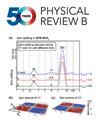Excited-state dynamics and optically detected magnetic resonance of solid-state spin defects from first principles
IF 3.7
2区 物理与天体物理
Q1 Physics and Astronomy
引用次数: 0
Abstract
Optically detected magnetic resonance (ODMR) is an efficient and reliable method that enables initialization and readout of spin states through the spin-photon interface. In general, high quantum efficiency and large spin-dependent photoluminescence contrast are desirable for reliable quantum information readout. However, reliable prediction of the ODMR contrast from first-principles requires an accurate description of complex spin polarization mechanisms of spin defects. These mechanisms often include multiple radiative and nonradiative processes, in particular, intersystem crossing (ISC) among multiple excited electronic states. In this work, we present our implementation of the first-principles ODMR contrast by solving the kinetic master equation with calculated rates from ab initio electronic structure methods then benchmark the implementation on the case of the negatively charged nitrogen vacancy center in diamond. We show the importance of the correct description of multireference electronic states and pseudo Jahn-Teller effect for quantitatively, even qualitatively correct prediction of spin-orbit coupling (SOC) and the rate of ISC. We present the complete calculation of SOC for different ISC processes that align with both group theory and experimental observations. Moreover, we provide a comprehensive picture of excitation and relaxation dynamics, including previously unexplored internal conversion processes. We show good agreement between our first-principles calculations and the experimental ODMR contrast under magnetic field. We then demonstrate reliable predictions of magnetic field direction, pump power, and Rabi frequency as important parameters for ODMR experiments. Our work clarifies the important excited-state relaxation mechanisms determining ODMR contrast and provides a predictive computational platform for spin polarization and optical readout of solid-state quantum defects from first principles.从第一原理看固态自旋缺陷的激发态动力学和光学检测磁共振
光学检测磁共振(ODMR)是一种高效可靠的方法,可通过自旋光子界面初始化和读出自旋态。一般来说,高量子效率和大的自旋相关光致发光对比度是可靠的量子信息读出所需要的。然而,从第一原理可靠预测 ODMR 对比度需要准确描述自旋缺陷的复杂自旋极化机制。这些机制通常包括多个辐射和非辐射过程,特别是多个激发电子态之间的系间交叉(ISC)。在这项工作中,我们介绍了第一原理 ODMR 对比的实现方法,即利用原子序数电子结构方法计算出的速率求解动力学主方程,然后以金刚石中带负电的氮空位中心为案例对实现方法进行基准测试。我们展示了正确描述多参考电子态和伪 Jahn-Teller 效应对于定量甚至定性正确预测自旋轨道耦合(SOC)和 ISC 速率的重要性。我们介绍了对不同 ISC 过程的 SOC 的完整计算,这些计算与群论和实验观测结果一致。此外,我们还提供了激发和弛豫动力学的全貌,包括以前未曾探索过的内部转换过程。我们的第一原理计算结果与磁场下的 ODMR 实验对比显示出良好的一致性。然后,我们展示了对磁场方向、泵功率和拉比频率这些 ODMR 实验重要参数的可靠预测。我们的工作阐明了决定 ODMR 对比度的重要激发态弛豫机制,并从第一性原理出发,为固态量子缺陷的自旋极化和光学读出提供了一个预测性计算平台。
本文章由计算机程序翻译,如有差异,请以英文原文为准。
求助全文
约1分钟内获得全文
求助全文
来源期刊

Physical Review B
物理-物理:凝聚态物理
CiteScore
6.70
自引率
32.40%
发文量
0
审稿时长
3.0 months
期刊介绍:
Physical Review B (PRB) is the world’s largest dedicated physics journal, publishing approximately 100 new, high-quality papers each week. The most highly cited journal in condensed matter physics, PRB provides outstanding depth and breadth of coverage, combined with unrivaled context and background for ongoing research by scientists worldwide.
PRB covers the full range of condensed matter, materials physics, and related subfields, including:
-Structure and phase transitions
-Ferroelectrics and multiferroics
-Disordered systems and alloys
-Magnetism
-Superconductivity
-Electronic structure, photonics, and metamaterials
-Semiconductors and mesoscopic systems
-Surfaces, nanoscience, and two-dimensional materials
-Topological states of matter
 求助内容:
求助内容: 应助结果提醒方式:
应助结果提醒方式:


